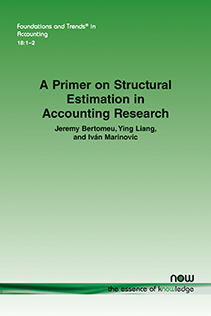A Primer on Structural Estimation in Accounting Research
By Jeremy Bertomeu, Olin Business School, Washington University in St. Louis, USA, bjeremy@wustl.edu | Ying Liang, J. Mack Robinson College of Business, Georgia State University, USA | Iván Marinovic, Stanford Graduate School of Business, Stanford University, USA
Abstract
This primer offers a hands-on accessible guide to writing and estimating structural models. We review commonly-used methodologies, including dynamic programming, maximum likelihood, generalized and simulated method of moments, conditional choice probabilities as well as tools to compute standard errors and common diagnostics and tests of economic hypotheses. Special attention is devoted to the bootstrap as a convenient toolbox to estimate complex economic interactions. The methods are illustrated with recent developments in earnings management, auditing, investment, accounting conservatism, and disclosure theory. Intuition and applications are emphasized over formalism.
A Primer on Structural Estimation in Accounting Research
A Primer on Structural Estimation in Accounting Research provides an introduction to researchers interested in incorporating structural models into their analysis. The monograph is designed for researchers with little or no prior knowledge of structural models and with the objective to make barriers to entry into this literature no greater than in other theoretical or empirical areas. The emphasis is on adequate use of the methods in applied work. While most examples are drawn from accounting research, many of the methods are applicable more generally to other related areas such as finance, marketing, and economics.
This primer is divided into eight sections, which are interconnected but can be also read individually. Section 1 presents two simple guided examples of structural estimation exercises where the logic of the main tools can be absorbed with minimal formalism. Section 2 presents a step-by-step approach to structural estimation, generalizing the methods applied in the two examples. Section 3 discusses more details of the econometric methods for readers interested in applying statistical concepts and widely-used mathematical formulas for estimators and their standard-errors. Section 4 discusses special topics required in estimation approaches using dynamic models, including dynamic programming. Sections 5, 6 and 7 discusses contemporary advances in the context of principal-agent theory, disclosure theory, and earnings management, respectively. Section 8 concludes the monograph.
